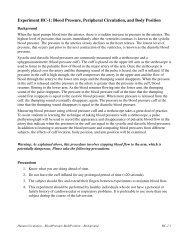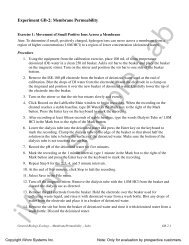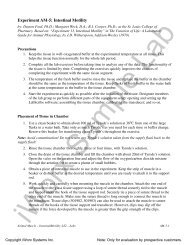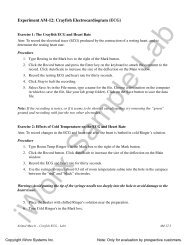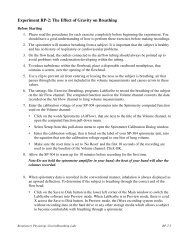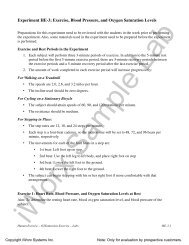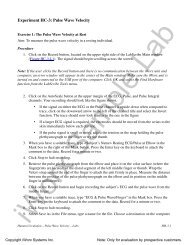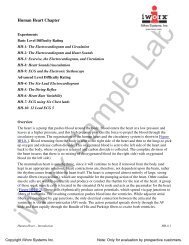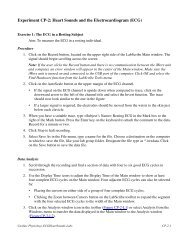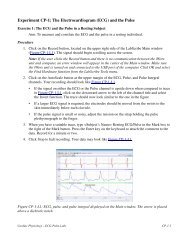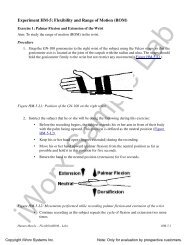Human Nerve Chapter - iWorx
Human Nerve Chapter - iWorx
Human Nerve Chapter - iWorx
- No tags were found...
You also want an ePaper? Increase the reach of your titles
YUMPU automatically turns print PDFs into web optimized ePapers that Google loves.
<strong>Human</strong> <strong>Nerve</strong> <strong>Chapter</strong>ExperimentsBasic Level Difficulty Rating: Can Be Done With:HN-1: Auditory and Visual Reflexes 3 AHK/214, HK/214, PK/214HN-2: Stretch Receptors and Reflexes 3 AHK/214, HK/214, PK/214HN-3: <strong>Human</strong> <strong>Nerve</strong> Conduction Velocity 4 AHK/214, HK/214, PK/214HN-4: Hand vs. Foot Reactions 3 AHK/214, HK/214, PK/214HN-5: Visual Reflexes and Color Stimulation 3 AHK/214, HK/214, PK/214OverviewDuring daily activities, animals must detect changes in their internal and external environments andreact to those changes in an appropriate manner to maintain a constant internal environment andrespond to changes in the external environment. In vertebrates, these functions are controlled by twoorgan systems that integrate and coordinate with each other, the nervous and the endocrine systems.Nervous systems perform these basic functions:• Receiving sensory input from the internal and external environments through receptors.• Integrating the inputs in a central location to determine an appropriate response.• Producing a motor response that causes one or more muscles to contract and move a body part,or cause an organ to release molecules that trigger responses in other cells or organs.The vertebrate nervous system is organized into two major divisions: the central nervous systems(CNS), which is composed of the brain and the spinal cord; and, the peripheral nervous system (PNS),which is composed of all the nerves not within the CNS. The majority of the nerves that are in the PNSare composed of the axons of nerve cells whose cell bodies (somas) are in the central nervous system.The peripheral nervous system is divided into the somatic and the autonomic nervous systems. Thesomatic nervous system senses changes in the external environment through receptors that respond tosound, light, taste, pressure, and odors. The receptors generate signals that is propagated to the brain orthe spinal cord through the sensory neurons in the peripheral nervous system. Once the signals areintegrated with additional information in the central nervous system, signals that control muscles aregenerated and propagated to the effected muscles through the motor neurons in the somatic nervoussystem.The autonomic nervous system is divided into the sympathetic, parasympathetic, and enteric nervoussystems. The sympathetic nervous system creates responses to impending danger or stress byincreasing physiological parameters like heart rate, blood pressure, and adrenaline levels. Theparasympathetic nervous system restores physiological parameters to levels normally seen during restand relaxation like a slow heart rate, vasodilation, and functioning of the digestive and urogenitalsystems. The enteric nervous system manages all aspects of digestion from the esophagus to the colonA reflex, like the myotactic reflex, is the simplest circuit involving a receptor, sensory nerves, thespinal cord, motor neurons, and muscle. The reflex is managed through single synapses betweensensory axons and motor neurons. The required circuitry for this reflex is confined to the spinal cord.<strong>Human</strong> <strong>Nerve</strong> – IntroductionHN-0-1
Sensory information also ascends to higher centers in the brain, but the brain is not needed to performthe reflex.More complex reflexes involve interneurons, that connect the sensory axons to the motor neurons, andmore than one population of motor neurons. Since more neurons and synapses are involved, it takeslonger to generate a more complex response to the stimulus. One example of complex response is theflexion withdrawal reflex, where a stimulus to one leg causes withdrawal of the stimulated leg andextension of the other.<strong>Human</strong> <strong>Nerve</strong> – IntroductionHN-0-2



